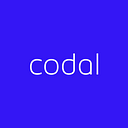A Day in the Life of a UX Designer
Like most UX designers, Sajkowski wears many hats. Between interacting with clients, sketching out ideas, working on wireframes, leading user testing sessions, and much more, she’s responsible for a lot. Her workload varies day to day, but there are some commonalities. Let’s examine what a “typical” day looks like for Sajkowski-if there is such a thing.
9–10 a.m. — Daily scrum meetings
Consistent with Codal’s commitment to Agile practices and procedures, each day begins with project scrum meetings. Scrums are the most fundamental component of the agile process. They serve as a recap of work that was completed the previous day and help teams get complete visibility into each individual designer’s workload for the current day. Codal design teams also use scrums to understand any barriers to completing work that designers face and hash out how to break down these barriers. These scrum meetings help design teams get an accurate picture of a project’s progress before completing another day’s worth of work.
“Each project we work on has a Mural virtual whiteboard with all of the tickets that we’re working on, and we use that to organize ourselves in the morning,” Sajkowski says. “It’s fun because they look like little Post-it notes on a board.”
10–11:30 a.m. — Sketching ideation session
During the early stages of a project, Codal design teams will collectively brainstorm design approaches and strategies. Taking place before the wireframing stage, these ideation sessions allow designers to get real-time feedback on sketches, helping to improve designs prior to their execution.
“We make decisions on interfaces pretty collaboratively,” Sajkowski says.
“Using virtual whiteboard tools, we take 20 to 40 minutes of individual, heads-down sketching time. Then, we take pictures of our sketches and post them to the project’s Miro board. After we present to each other and talk through different ideas, a UX designer will start to create wireframes based on these sketches.”
11:30 a.m.- 12 p.m. — Internal design review
Once team members have completed designs, the project design team comes together to review the work and offer feedback. Instead of brainstorming or ideating design approaches, the project teams are giving sign-off on designs prior to sharing them with the client — and identifying any areas that may need improvement.
These sessions review individual designs in the context of the larger product or solutions. This helps to make sure designs stay practical and prioritize the end user,
“Often, the development team is present for these internal design reviews. This is beneficial because it helps us make sure that we’re building something feasible,” Sajkowski says.
12–1 p.m. — Lunch
Even UX designers need to eat. Plus, taking some time away from the screen helps Sajkowski refresh her eyes. When ordering in, Sajkowski is partial to Onigiri Shuttle KORORIN -a favorite of the design team in Chicago.
1–2 p.m. — Client presentation
After designs clear the internal review process, it’s time to share them with clients to get their feedback and approval. Codal’s design teams work very closely with our clients to ensure our work meets — or exceeds — their expectations. Each of our designers takes an active role in engaging with clients to ensure our work is up to snuff.
“One way that Codal differs from other agencies is that each designer presents their own work to the client,” Sajkowksi says. “Some agencies have the director of design present and interface with the client. But instead, Codal designers are very client-facing.”
2–4 p.m. — User testing sessions
A key element of Codal’s design approach is user testing. This crucial step in the design process allows teams to validate their design choices and get feedback on a product or solution’s usability from the most important stakeholders: the actual users.
“So the client will help us recruit members of the user group that they are building their product for,” Sajkowski says. “We’ll guide them through tasks on a clickable prototype, watching closely to see how they approach the tasks and getting their feedback in real time.”
“After testing, we’ll do a synthesis session to collaboratively discuss where we saw issues and how to solve those issues. Then we share our findings with the client.”
Depending on how test users engage with a product or solution, these testing sessions could send the design team back to the drawing board. But it’s worth it to ensure usability and provide the best possible user experience.
4–5 p.m. — Design team book club
Codal design teams are committed to continuous learning and development. In order to deliver cutting-edge design services to our clients, it’s essential that Codal designers stay on top of industry trends and best practices, as well as in the know about new technologies.
Codal designers created book clubs to help team members learn new skills and perspectives, and discuss what they’ve learned with others. It’s a valuable opportunity for knowledge sharing and professional growth.
“We actually have two book clubs, one for UX and one for UI,” Sajkowksi says. “We’re currently reading “Design Systems” for UI, and the one for UX is ‘User Story Mapping.’ “
“It allows us to learn, share, and grow as a team. It’s a nice little Friday afternoon activity, a great way to end the week.”
Originally published at https://codal.com.
